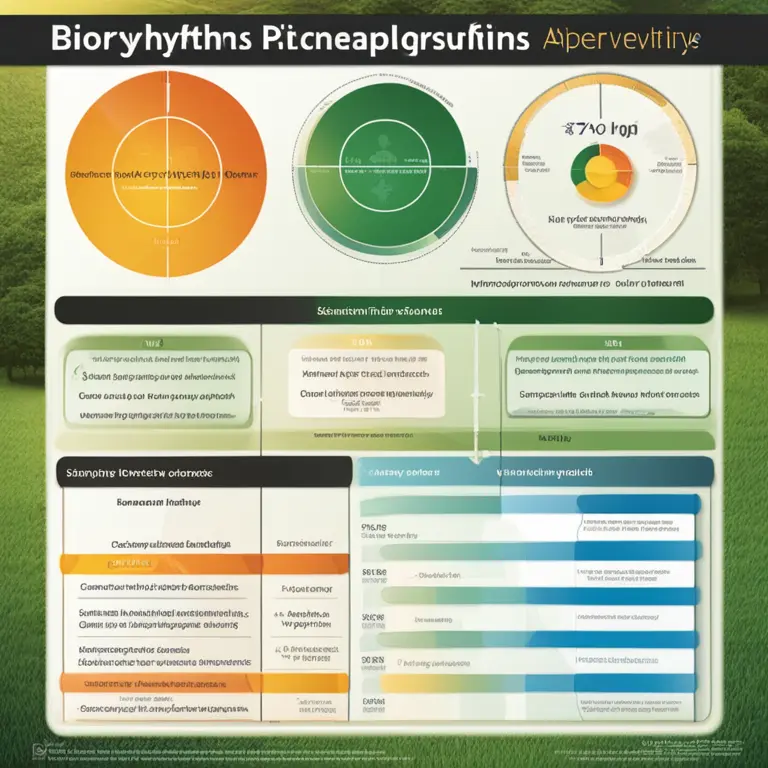
The Basis of Biorhythms: A Guide to Biological Cycles
Explore the foundational principles of biorhythms and learn how our physical, emotional, and intellectual cycles influence daily life.
article by Adrian Wallace
The Science Behind Biorhythms
Understanding biorhythms begins with recognizing that human life is inherently rhythmic. From the steady beat of the heart to the ebb and flow of monthly hormonal cycles, biorhythms underlie many aspects of our physical existence. But what exactly are biorhythms in the context of this discussion? Biorhythms refer to the theoretical cyclic patterns that purportedly regulate various physiological functions. These rhythms are said to influence our physical, emotional, and intellectual states, potentially impacting everything from performance to mood.

Three Primary Cycles
Traditionally biorhythms are divided into three essential cycles: physical, emotional, and intellectual. Each is described as operating on a distinct, predictable schedule. The physical cycle, running on a 23-day period, might govern aspects of stamina and coordination. The emotional cycle, which cycles every 28 days, is thought to affect mood and creativity. Lastly, the intellectual cycle, said to be on a 33-day rotation, purportedly influences logic and reasoning. Understanding these cycles' timings can, in theory, help individuals gauge their days of peak performance or alert them to periods of potential vulnerability.

Historical Context and Acceptance
The concept of biorhythms dates back to the late 19th and early 20th centuries, with the work of figures like Dr. Hermann Swoboda and Dr. Wilhelm Fliess. The theory experienced a surge in popularity during the 1970s but did not gain widespread acceptance in the scientific community due to a lack of empirical evidence. Nevertheless, in the era of wellness and self-optimization that defines 2024, biorhythms have found a new audience among those seeking to harmonize with their body’s natural rhythms.

Criticism and Current Views
Modern science often criticizes biorhythms for lack of robust, reproducible evidence. Critics assert that the strict, unchanging cycle lengths for all individuals oversimplify human physiology's complexities. However, as wearables and biofeedback technologies advance, new discussions emerge about how personalized data could offer a more tailored view of potential physiological cycles unique to the individual, thus renewing interest in certain aspects of the biorhythm theory.

Practical Applications and Technologies
Despite skepticism from the scientific community, biorhythm enthusiasts believe that by plotting these cycles, one can predict optimal and suboptimal periods for various activities. Innovations in biometric technology potentially allow for more personalized tracking, leading some to suggest digital biorhythms could become an actionable tool for personal health and wellbeing. While apps and wearables are not yet mainstream for predicting biorhythmic patterns as of 2024, there is speculation about the possibility and implications.
Biorhythms and Daily Life
Whether one subscribes to the principles of biorhythms or not, the overarching idea encourages a closer look at how bodily rhythms affect day-to-day living. From circadian rhythms—scientifically backed daily cycles correlated with the earth's rotation—to the menstrual cycle, acknowledging natural fluctuations is integral to health. The biorhythm concept similarly invites individuals to consider how their bodies' unseen rhythms might influence their lives, even if the specifics of the theory remain debated.
Published: 1/30/2024
Modified: 1/30/2024
More predictions
Come back here soon to learn more about yourself and your future


Between Biorhythm & Compatibility: Sync Your Cycles
Discover how biorhythm compatibility can impact relationships and find harmony by syncing your physical, emotional, and intellectual cycles.


The Rhythms Within: An Insight into Biorhythms
Discover the science and philosophy behind biorhythms, the cyclical patterns our bodies follow, in connection with our physical, emotional, and intellectual states.


Biorhythm Compatibility: Sync Your Cycles for Harmony
Discover the intriguing connection between biorhythms and relationship harmony. Learn how syncing your biological cycles can foster deeper compatibility.